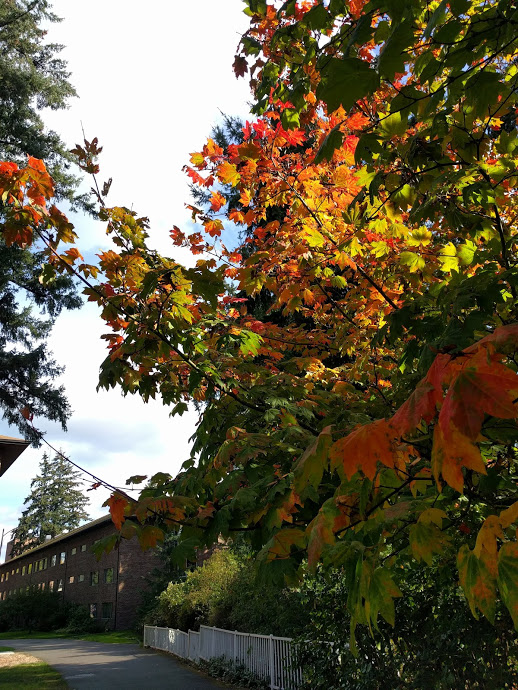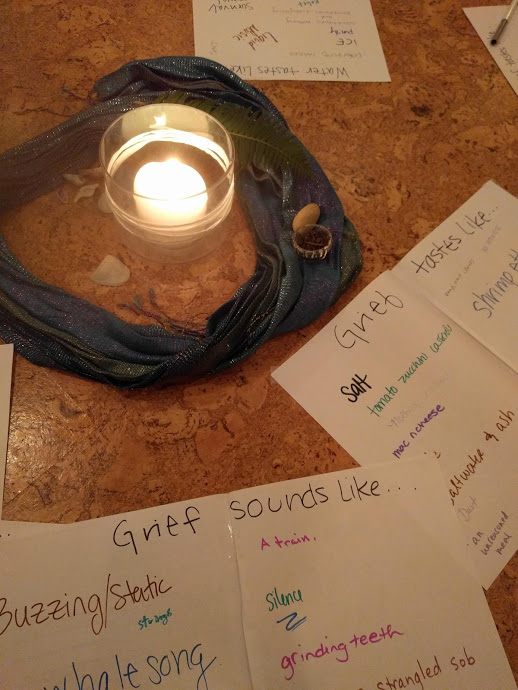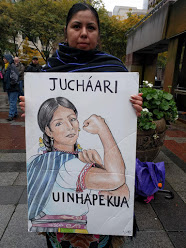Tension: The Unpopular Guest At The Thanksgiving Table (And What, Perhaps, To Do About It)
Nov 19, 2018Fall is a complicated season. At once is the abundant burst of summer’s finale. Apples and leaves dangle from trees like ripened jewels; farmer’s market stands overflow with delicata, pumpkins, beets and other vegetatious bounty; and glorious reunions and memory-making of school time and holidays quick-step us into the new year. Beauty and richness and fullness and delight.

And at the same time, at least in the northern hemisphere, amidst the jubilant cacophony of color and flavor, there is another equally present undercurrent happening in the natural world: the slow breath out, the descent into winter, the lengthening of nights, the cooling of days. The earth is dying. Life is happening all the while death is happening, and that beautiful melancholic middle place is a kind of tension that can be both rich and unwieldy.
This tension can manifest in many different ways, in the pairings of seemingly unreconcilable opposites that show up at this time. In my exploration over the years, I continue to seek and wonder: is it possible to hold these tensions with a sense of spaciousness? Is it possible to name them, invite them in and make room for them? Here are a few tensions that I experience, and how I practice living with them.
1. The tension between joy and sorrow. For many, this time of year can be of long-awaited and celebratory reunions with beloved ones and the excitement and revelry of traditions, and time off. However, for those who’ve have lost loved-ones in the previous year or years, or for whom family is not a place of health and respite, the family focus or an innocent “happy holidays” greeting can carry a sting to it. For many years I experienced pretty severe depression around the holidays. It took me years to name it, and many more to sift through why it was happening. During this time, I stopped spending holidays with my family—not because there isn’t a great deal of love and beauty there, but because in the detective work of identifying the source of my depression, I just had to simplify the factors and dynamics at play. I struggled with unspoken internal and external pressure to “put on a happy face” even though it often felt forced and inauthentic.
Holidays can be a grieving time, and there’s little the cultural norms that normalize or make room for that. Even grief itself can be complex, carrying the bittersweet of memories and appreciation for what was even in the pain of its present absence. What I try to encourage for myself and others is to give more space to listen for and respond to your own inner landscape during this time. Keep the company of those who can hold you in your full spectrum of feelings. Take time out from “expected” events and functions. Soften expectations around your self for this time of year to “feel good”. It doesn’t have to.

Our alter and reflections from this fall’s Grief Series
2. The tension in what is said and what remains unsaid about the history of “holy” days. There is a deep tension for me in what we call and the way we celebrate holy days of this season. Take Thanksgiving, just around the corner. Contrary to the long-maintained myth of the “first Thanksgiving,” inspired by pilgrim and native cooperation, in all likelihood the first actual feast that would become institutionalized as Thanksgiving was actually a celebration in wake of a brutal massacre of the Pequot Indians by colonists led by Captain John Mason, in 1636. Over 700 men, women and children were rounded up and murdered at the mouth of the Mystic River in what is now Connecticut. I didn’t know about this until about two years ago, and it continues to disturb me deeply that our culture-wide calendar continues to observe this day, feasting as a holy day, most of us on stolen or unceded indigenous land. (Learn more about this history here.)
- How do we hold this tension and not be the biggest self-righteous drag at holiday functions? I can’t say I have mastered that. However, a few things have surfaced that are helping me at least explore the tension more deeply and spaciously:
-
Acknowledge the indigenous ancestry of the land upon which I am dwelling. (Find out what territories you live on and their tribal histories here.)
-
Light a candle with those I spend time with over the holiday, and speak aloud the memory of the Pequot natives murdered by my ancestors and covered up by my culture
-
Consider a fast instead of feast. Contribute money that would have been spent on decadent foods to movements like the National Day of Mourning and Unthanksgiving Day happening nation-wide
-
Support and attend local observations like the Annual Sunrise Ceremony at Heritage Park in Olympia, and National Day of Mourning Fundraiser at Rainier Beach Yoga
-
Continue to learn and remain in support of the work of indigenous sovereignty throughout the rest of the year; as well as to educate myself against white-washed versions of history, and work against white cultural norms that overtly and covertly maintain white supremacy. (The work of Tada Hozumi has been instrumental to me in this—check out last month’s blog to learn more about anti-racist ancestor work).
These feel like woefully inadequate gestures. I imagine and await the day when we—white folks, in particular—are collectively fasting on Thanksgiving instead of feasting, actively grieving the wrong-doing of our ancestors and the continued erasure of indigenous peoples, and observing this single day as a catalyst for the rest of the year’s labor towards the liberation of all.

A comrade at Indigenous People’s Day, October 11th, in downtown Seattle (used with permission
3. The tension between the sound and silence. Over Samhain, the pagan holiday we now call Halloween, I spent five days in silence. Ok, not total silence—we had teaching sessions two or three times a day, and we used words to attend to the daily details of serving meals and cleaning up. But in between that, my fellow retreatants and I held silence. What is there to even say about silence? If anything, I’m inclined to use less words and simply advocate for the experience of it. In our sound-saturated world, I had almost forgotten what silence felt like and where it could take me. After five days of it, and only once I began to emerge did I have perspective on how deep the silence had taken us. It was as if time had suspended and the mist that rose from the bay below had swept us into another realm. It was the most profound contact with the Real that I have experienced in a long time.
Fall carries us into the season where silence rules. Long nights beckon for activity to slow, for bulbs to incubate, for bark to close in, for compost to layer thick over humus, under which worlds are quietly incubating and ruminating and shifting ever so subtly. The slowing of the natural world is, to my own body and being, harshly juxtaposed by the annual fall and winter customs of cultures. Don’t get me wrong—I love carols and pie and crafting and giving thanks and getting presents! My theory is, though, that the revving of holiday season causes a deep dissonance to the creaturely-ness of our physical bodies that are a part of nature—and in as such, yearn deeply to align with and settle into where the cycles of nature take us now: into darkness, quietude, stillness.
For me, that means slowing down and under-committing (even more than normal, much to the disbelief of those who love me and already find me terribly unavailable!) It means being ok being a disappointment to others. It means unplugging, for a time, from electronics, social functions, even fun things that I enjoy! so that I can truly plug into reality—into God/dess, the rhythms of Earth, and the quiet speaking of own heart. If you are seeking more silence and contemplative space during the coming season, consider signing up for my fall series, Stillness at the Center (starts next Tuesday! Just a couple of seats left!)

In all of this, fall to me means embracing the dissonance of tension unresolved, of practicing delight in what is full and abundant and being ok if things don’t feeling good or happy. Like the balance of breath in and breath out, I think it is possible with care and attention to move through this time with at least some spaciousness amidst the tension—allowing it to be, moving with the fluctuations, and making room for ourselves to be however we are across the spectrum of joy and sorrow, light and dark, clarity and confusion, fullness and emptiness, life and death.
What are the tensions you notice at this time of year? I’d love to hear about your experience in the comments below, and how you navigate it!
Sending you ease and strength in the tensions of Autumn,
Kate

